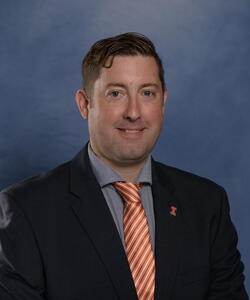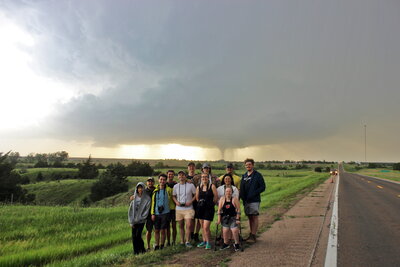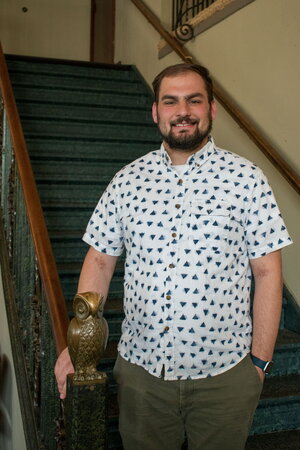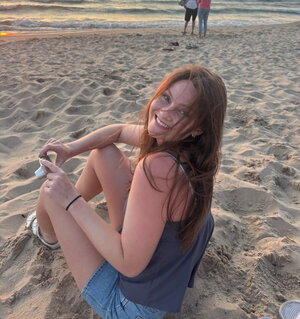Climate, Meteorology & Atmospheric Sciences Fall 2025 Newsletter
Title
A Final Look From Above
In December 1999, Larry Di Girolamo stood at Vandenberg Air Force Base, watching the launch of the Terra satellite. Aboard was the Multi-angle Imaging SpectroRadiometer (MISR), an instrument he had worked on since graduate school. Designed to last six years, MISR would remain in operation for 25 years, outlasting expectations and transforming what scientists know about pollution, weather, and climate change.
Initially intended to gather statistics about clouds and aerosols, MISR has become the longest continuous climate-quality satellite record. One of its final contributions confirmed a long-held theory: the jet stream is shifting and speeding up, with global consequences.
Learn more about Larry's journey with the MISR Instrument and its latest discovery
Message from the Head

There is a Japanese proverb, “Nana korobi, ya oki”, which means “Fall down seven times, stand up eight.” I think this proverb fits the current times those of us in atmospheric sciences face in many ways today. Many of you in our community have been directly affected by actual or threatened public sector layoffs, center closures, grant suspensions, and terminations. In my conversations with alumni and folks in our community over the past year, the need for what we do as meteorologists and climate scientists hasn’t gone anywhere, but who pays for it and who does it is in a state of flux. This presents challenges and opportunities that all of us in CliMAS are navigating, necessitating strategic planning, retooling, and choosing how to fulfill our teaching, research, and service missions as a Department.
Fortunately, we’ve been the beneficiary of rock-solid leadership at the State, University, and College levels here at Illinois. This has enabled us to support our faculty and students. Congratulations go out to professor Jeff Frame, who has been promoted to teaching professor, and professor Joseph Trujillo-Falcón, who was appointed assistant professor after serving for a year as a distinguished postdoctoral research associate. In addition, two administrative appointments recognizing leadership in the department were created: professor Jessie Choate, who was named director of undergraduate studies, and professor Alicia Klees, who was named director of online studies.
As you see elsewhere in this newsletter, there is a lot of good news in our department despite the federal headwinds. Our freshman class continues to be sizable: we welcomed 15 new students this year! Our online graduate program has grown, and we now house the largest online graduate program in the nation! And our faculty, graduate, and undergraduate students continue to be recognized by international, national, and university awards. Acknowledging the challenges we face, however, we are thankful for those who support the department through donations and by volunteering their time to speak with our students, and we welcome any contribution you’d like to make to help the department. Feel free to contact me if you’d like to chat about what you can do to contribute to CliMAS!
2025-26 Distinguished Lectures

Turco Distinguished Speaker
Our 2025-2026 Linda S. and Richard P. Turco Distinguished Speaker is professor Jennifer Kay from the Department of Atmospheric and Oceanic Sciences at the University of Colorado-Boulder. Dr. Kay’s research interests include coupled atmosphere-ocean-ice processes, cold cloud and precipitation physics, sea ice, forcing and feedbacks, and internal variability. The tools we apply include remote sensing observations, in situ observations, process models, coupled models, instrument simulators, and data assimilation. We look forward to her visit in November!

Our Distinguished Alumni Speaker for 2025-2026 will be professor Katherine Hayhoe. She is a Paul Whitfield Horn Distinguished Professor and an Endowed Chair in Public Policy and Public Law at the Texas Tech University Department of Political Science. In 2021, Hayhoe joined the Nature Conservancy as Chief Scientist. Professor Hayhoe received her PhD under the advisement of Prof. Don Wuebbles in 2010. She is an expert in climate science and climate impacts and frequently appears in the media on topics related to climate change, as well as reconciling her Christian faith and climate change. She’ll be visiting campus during Spring 2026.
We’d Love to See You at AGU & AMS!
Join CliMAS at AGU on Monday, December 15th, from 6:30 to 8:30 p.m. in Room Strand 10AB at the Hyatt Regency New Orleans.
Our CliMAS AMS Alumni Reception will take place on Tuesday, January 27th, from 7:00-9:00 p.m. in the Lanier Grand Ballroom C at the Hilton Americas-Houston.
We look forward to seeing you at either or both of these events!
Title
Weather Realness Podcast is now live
This August, Illinois Public Media premiered a new weekly radio program and podcast, a partnership with the Department of Climate, Meteorology, and Atmospheric Sciences in the School of Earth, Society & Environment at the University of Illinois Urbana-Champaign. Weather Realness brings the best weather and climate scientists in Illinois to help the public understand weather and climate by providing scientific facts and enlightening conversations.
Degrees Awarded
- Elizabeth Abbamonte
- Nathan Beno
- Zoe Caryl
- Kyle Cusac
- Dominic Dragon
- Forest Garty
- Anthony Grimes
- Jason Lilek
- Abigail McDonnell
- Jason Miller
- Jane Umhofer
- Kyla Wolski
- Samuel Frederick
- Tyler Hanke
- Kaitlyn Jesmonth
- Joseph Nied
- Deffi Putri
- Maile Sasaki
- Jacqueline Melanie Sepulveda
- Jessica O. Skocinski
- Zachary Solecki
- Garrett Statum
- Rachel Tam
- Brandon Bourassa
- Roger Claybrooke
- Shelby Orian Kniss
- Bradley Wallet
- Shijia Zhang
- Alexander Adams
- Carolina Bieri
- Chu-Chun Chen
Field Studies of Convection Course

Thirteen students participated in the May Field Studies of Convection course trip this year, while eleven students enrolled in June. On May 23, we made the long drive from Urbana to Kit Carson, Colorado, where we observed a tornadic supercell with gorgeous structure as the sun set. Other highlights from the May trip include long-tracked supercells in central Texas on May 25-26, a dusty but structured supercell in western Texas on May 29, and surprisingly good storm structure on a multicellular storm in a marginal environment in the Texas Panhandle on June 2. The June group saw an active start, observing a large wall cloud in southern Minnesota on June 12, beautiful storms in western Nebraska on June 13-14, and again the Dakotas on June 19-20.
The highlight of the season, however, was on June 16, when we observed a tornado that lasted for nearly an hour beneath a structured supercell near the town of Wellfleet, Nebraska. This ranks as Prof Frame’s best tornado/storm structure combo of his career and his third-best storm intercept of all time. Most days this season featured slow-moving storms, allowing us to safely view them for long periods from the same location. Students provided substantial input in the decision-making process, both during our morning briefings and as we were following storms.
Department Awards
- Zhuo Wang
Fellow of the American Meteorological Society, 2026 - Cristian Proistosescu
Center for Advanced Study Fellow, 2025 - Sonia Lasher-Trapp
Outstanding Teacher for CliMAS Graduate Course, Outstanding Graduate Mentorship - Nicole Riemer
Outstanding Teacher for a CliMAS Undergraduate Course - Jessica Choate
Outstanding Undergraduate Mentorship - Shiv Priyam Raghuraman
2024 ACP Paul Crutzen Publication Award
- Jessie Loveridge
Ogura Outstanding Research Paper - Joseph Nied
Making the Department a Better Place Award - Jackie Sepulveda
Making the Department a Better Place Award – Honorable Mention - Chu-Chun Chen
Turco Climate Paper - Michie De Vera
Operational and Applied Meteorological Research Award – Honorable Mention - Matthew Graber, Garrett Statum
Teaching Assistant Award
- Forest Garty
Ogura Award for Outstanding Senior - Eliza Abbamonte, Zoe Caryl, Forest Garty, Abigail McDonnell, Jane Umhofer
Outstanding Undergraduate Research Paper
- Charlie Remmers
Mankin Mak Scholarship - Matthew Perry
Alumni Scholarship - Andrew Lapinskas
Faculty Scholarship - Alyssa Shih
Bob and Ruta Rauber Scholarship - Grace Van Dyke, Ari Anderson
The Field Studies of Convection Scholarship
Title
ISTORM UPDATE
ISTORM enjoyed a standout year of community-building, outreach, and service. The student AMS chapter raised more than $1,200 for disaster relief efforts following hurricanes and wildfires, collaborated with student groups nationwide, and strengthened ties on campus through joint events with the CliMAS Graduate Student Organization. Members led weather-education programs for local scouts, dazzled families at Engineering Open House with hands-on demonstrations and balloon launches, and connected through a full calendar of social gatherings. Professional development also thrived, with faculty talks, internship panels, new forecasting tools, and a strong undergraduate presence at AMS 2025.
Online programs
We are thrilled to share that both the online graduate certificate and online Master of Science programs continue to experience sustained growth. Currently, there are 28 students pursuing our online master’s degree, and 31 students pursuing our graduate certificate! Five students graduated from the online MS program between Fall 2024 and Summer 2025—Shelby Kniss, Brandon Bourassa, Scarlett Zhang, Brad Wallet, and Duanne Claybrooke—as did 7 graduate certificate students. To broaden the curriculum in our online programs, we are developing courses focused on numerical weather modeling and advanced statistics, and we also continue to evolve our current courses to reflect advances in data science. Additionally, we are in the process of spinning up a climate solutions-focused online graduate certificate in collaboration with the UIUC Prairie Research Institute - stay tuned!
Graduates have spoken highly of the impact of the programs on their professional and personal growth. Spring ‘25 online MS graduate Duanne Claybrooke reflects, “The knowledge gained during this experience has been very rewarding and very applicable in today’s world. Even though I’m just finishing the degree, it has already helped me to advance in my field with a new position.” Spring ‘25 online certificate graduate Corinne Wolf (CliMAS BS ‘23) emphasizes how meaningful the sense of connection was throughout her time in the program: “although the program is fully online, you still feel as though you have a community of people around you in the same boat, always willing to help you out.”
We are grateful to alumni and friends of the department who have generously shared career advice and feedback with graduating online MS students. We are always looking for more alumni to engage with our students; please reach out to Dr. Alicia Klees (aklees@illinois.edu) if you are interested!
Distinguished Lectures
The department hosted two special lectures this year: the Annual Ogura Lecture, which is possible through the generosity of Department Founder Yoshi Ogura, and the Annual Turco Lecture, which is possible through Linda S. and Richard P. Turco. Richard holds a 1971 Ph.D. in Electrical Engineering and Physics from UIUC, who is renowned for making contributions to the chemistry and physics of planetary atmospheres, and global climate change.

Dr. Adam Sobel, Professor and the director of the Extreme Weather and Climate program at Columbia University, presented the annual Ogura Lecture on April 25, 2025. His lecture, “Doing Usable Climate Risk Science in Academia,” explored the growing need for better climate risk information to help communities adapt to a changing climate. Traditional climate data often doesn’t meet practical needs, creating confusion and inconsistency in understanding risks. Dr. Sobel called for more coordinated, transparent efforts by scientists and public institutions to provide reliable, useful information, as illustrated through new research on how climate change affects hurricane risks.

The Turco lecture, hosted on October 22, 2024, featured Dr. Mark Zelinka, Climate and Atmospheric Scientist at| Lawrence Livermore National Laboratory, Livermore, and an IPCC 6th Assessment Report author. His lecture, “Clearing the Clouds of Uncertainty,” examined why clouds remain one of the most significant sources of uncertainty in predicting future climate change. Because clouds strongly influence how much heat the Earth retains, even small changes in their behavior can significantly affect global warming projections. Dr. Zelinka explained why clouds have long challenged scientists and highlighted recent advances that are helping to estimate Earth’s climate sensitivity to carbon dioxide, the most important greenhouse gas impacting the climate.
Distinguished Alumni Award
The Department hosted Dr. Louis J. Wicker from the National Severe Storms Laboratory to award him the 2025-2026 Distinguished Alumni Award. Lou is a senior research meteorologist at NOAA’s National Severe Storms Laboratory whose career centers on severe-storm dynamics, convective-scale data assimilation, storm-scale prediction, and computational physics.

He serves as Chief Scientist for NOAA/NSSL’s Warn-on-Forecast System (WoFS) program, advancing probabilistic, high-resolution tornadoes and other hazardous convection predictions. He co-chairs the Unified Forecast System Convection-Allowing Model (UFS-CAM) working group and has held key advisory roles for WRF/MPAS. A 2024 AMS Fellow, he previously edited the Journal of the Atmospheric Sciences. Wicker has been integral to landmark community efforts—co-founding the SMART mobile radar program, serving on the VORTEX-2 steering committee, and leading NSF- and NOAA-supported research. His publication record spans foundational model-dynamics papers to operationally relevant WoF and ensemble-forecasting studies, with sustained mentorship of graduate students and postdocs across Texas A&M, Oklahoma, and NOAA collaborations. He earned his Ph.D. in Atmospheric Sciences from the University of Illinois in 1990.
Dr. Wicker gave an engaging seminar about the influence of Illinois on his career and the field of convective storm modeling. He also discussed the WoFS, its capabilities, and future potential. He and his wife, Kristy, enjoyed telling stories about the department in the late 1980s and revisiting some old haunts in Champaign-Urbana during a beautiful September period. We all enjoyed hearing about Lou’s involvement in our department’s past as well as his current and future research activities, which are helping to advance how severe weather is predicted in the US.
Title
She walks the line: How scientist Katharine Hayhoe’s faith drives her research on climate warming
Katharine Hayhoe (MS ’97, PhD ’10) has built a career around making climate science accessible—and personal. A world-renowned atmospheric scientist, Hayhoe bridges divides that often seem irreconcilable: she is both a devout Christian and a leading voice on climate change. Her work reaches audiences across political, cultural, and religious lines, driven by the belief that “climate change is not just an environmental issue, it’s a human issue.”
At Illinois, Hayhoe found both her academic foundation and a community that supported her scientific and spiritual growth. Guided by mentor Don Wuebbles, she developed tools to make climate models more meaningful at local levels—a focus that would become her life’s work. Today, Hayhoe serves as chief scientist at The Nature Conservancy, has authored over 150 scientific papers, and continues to inspire action through books, public speaking, and policy advocacy. Her message remains clear: climate action starts with conversation, and love—for others, for the planet—is the most powerful motivator of all.
Read Katharine's full story in this story from the Illinois Alumni Magazine
Student Profiles

Meet PhD Student, Rachel Tam:
Meet Rachel Tam, a Ph.D. graduate student and RA from Hong Kong! She is interested in all aspects of earth science. Her undergraduate major is Oceanic and Atmospheric Sciences. This seasoned learner has tips for new students. “I wish I were better prepared to be comfortable with being uncomfortable at times. Things often don’t go as expected, but there’s still a lot within your control. Maintaining a healthy attitude and good mental well-being can take you a long way. Graduate school and research are more like a marathon than a sprint.”

Meet Undergraduate Student, Ryan Salamon:
Hailing from a little town in northern Illinois, you might not have heard of (Pecatonica), we are confident you will hear more about Ryan! Ryan was originally interested in winter weather management, but he is now focusing on wildfire risk communication and analysis of NWS (National Weather Service) Red Flag Warnings. His future goals include obtaining an MS, a PhD, and a JD, and working for the National Park Service or the Forest Service. In his spare time, you can find Ryan as a student section leader for Illinois Football or watching reruns of “How I Met Your Mother!”

Meet Undergraduate Student, Olivia Samolej:
Also coming from northern Illinois (Naperville), it seems appropriate that Olivia is studying the predictability of winter weather and its impacts on rural communities. What drew her to UIUC? “It was the opportunity to attend a large university while still being part of a tight-knit community. I was also drawn to the endless opportunities to get involved and grow within the department.” Olivia is also the treasurer for iSTORM (Illinois Student Organization of Meteorology) and, like Ryan, is a huge Illinois football fan and is a “blockhead” for the team!
Give Today, Help Tomorrow!
How You Can Help
Our students are the next generation of atmospheric scientists, innovators, and leaders. Your gift of any size helps us ensure that they have the support they need to be successful at Illinois and beyond.
Thank You to our donors in 2024-25
- Rosemary Roberts
- Earl Barker
- Bob and Ruta Rauber
- Don and Barbara Wuebbles
- Huei-Ping Huang
- Ryan Sriver
- Jeff Trapp and Sonia Lasher-Trapp
- David Werth
- Nicole Prenevost